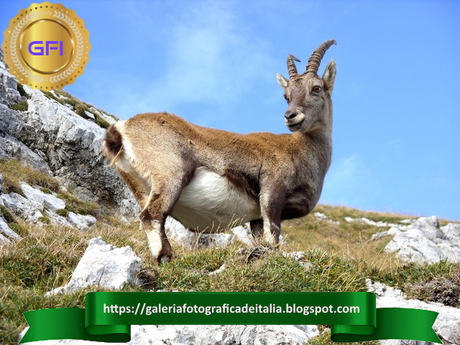The Stelvio National Park is one of the oldest Italian natural parks.
It was born with the purpose of protecting the flora, fauna and beauties of the landscape of the Ortles-Cevedale mountain group, and to promote the development of a sustainable tourism in the alpine valleys of Lombardy, Trentino and Alto Adige.

The Stelvio National Park is one of the oldest Italian natural parks.
Index of contents: [ hide ]
Stelvio National Park.
It extends over the territory of 24 municipalities and 4 provinces and is in direct contact with the north with the Swiss National Park, to the south with the Adamello-Brenta provincial natural park and with the Adamello Regional Park.
All these parks, together, constitute a vast area in the heart of the Alps that reaches almost 400 000 ha.

View of the park, from the Braulio valley .
Location and morphological characteristics.
Located on its 130,700 hectares, in the heart of the Central Alps, the Stelvio is a typical high altitude mountainous park: for approximately three quarters, its territory is above 2000 meters and reaches a maximum of 3,905 meters at the top from 'Ortles.
Thanks to the high average altitudes, it is characterized by a succession of inaccessible peaks and vast glacial surfaces. The Ortles-Cevedale group, on the border between Lombardy and Trentino-Alto Adige, constitutes its geographical heart.

Located in the heart of the Central Alps, the Stelvio is a typical high altitude mountainous park.
The rocky basement consists mainly of metamorphic rocks (gneiss, phyllites, mica schists) and, to a lesser extent, igneous rocks (granites). The presence of sedimentary limestone rocks (mainly dolomite) in the north-western area of the Park is quite special for the internal Alps.
Read also: The Abruzzo is a region of central Italy, on the Adriatic shores with a third of the region classified as a national or regional park.
The areas of the valley floor are characterized by the presence of hay meadows, while the slopes are dominated by coniferous forests; climbing again, we reach the alpine meadow, which, with the increase in altitude, becomes increasingly discontinuous to make way for those species that grow, as isolated specimens, even at very high altitudes.
Flora and fauna.
Here life, especially for plants that can not escape the rigors of weather, becomes difficult.
Despite the very low temperatures (even well below -20 ° C and with averages that do not exceed 10 ° C in summer), strong winds (with average speeds close to 50 km / h at higher altitudes) and abundant snowfall (the total accumulation of fresh snow can exceed 7 m), many plants can survive even at more than 3,000 m altitude.

Flora in the V Alpine refuge of the Zebrù Valley.
The fauna counts, only among vertebrates, more than 260 species. It should be noted, to summarize the wealth of fauna of the Park, the important presence of large raptors (golden eagle and bearded vulture), the rich populations of ungulates (especially deer and mountain goats) and the presence of many species typical of habitats. . mountain (alpine galliformes, marmot, white hare, ermine, etc.).
To them is added the myriad of invertebrates that also live, sometimes, in extreme conditions.

As we go up in altitude we find rupicapras and, in the valleys, ibex.
A park rich in history.
In addition to being a park with great landscapes and exuberant nature, the Stelvio is also a park rich in history. During World War I, the western end of the battle front ran here.
Many traces of these tragic events, the struggle for survival against extremely difficult environmental conditions against men, still remain today, especially in the Valle del Braulio and Passo dello Stelvio, in the Valle dei Forni and in the Valle di Gavia .
Military roads and mule tracks, trenches and military villages are still a testament to the events of the "White War".

Mountain tour from Cogolo di Peio to M.ga Levi in the Stelvio National Park (Italy).
The Stelvio National Park was born on April 24, 1935 with the administration entrusted to the State Agency of State Forests and the State Forest Corps.
Since 1995, for twenty years, it has been administered by a consortium between the State, the Lombardy Region and the two autonomous provinces of Trento and Bolzano.
With the entry into force at the end of February 2016 of the legislative decree 13 January 2016, n. 14 the consortium was abolished and the administrative functions, for the territory of their respective competence, were transferred to the Autonomous Provinces of Trento and Bolzano and to the Region of Lombardy, which administers the Lombardy area through Ersaf / Regional Services Agency Agriculture and forestry. The unitary configuration of the Park is guaranteed by a special Coordination and Direction Committee.
Supervision of the park area.
The supervision of the area of the Park is exercised by Carabinieri Parks Reparto NP "Stelvio" in Lombardy and by the Provincial Forestry Body in the provinces of Bolzano and Trento.
Read also: True roof of Europe, Valle d'Aosta is the Italian region with the highest mountains in the Alps.
The protected area covers twenty-three municipalities, more or less widely included within it (ten in Lombardy, ten in the Province of Bolzano and three in the Province of Trento).

Panorama of Malga Mare on Lake Lungo at 2553m. of altitude
Each one of the municipalities of the Park is an ideal starting point to explore the protected area.
Its 1500 km of trails allow you to venture out to discover the nature and the human landscapes of the Stelvio.
The visitor centers are the ideal place to deepen the knowledge about the most diverse aspects of such a rich environmental reality.
At the information points, it is possible to have all the useful information about the protected area and about the many initiatives (excursions, workshops, guided tours, various events) organized by the Park.
